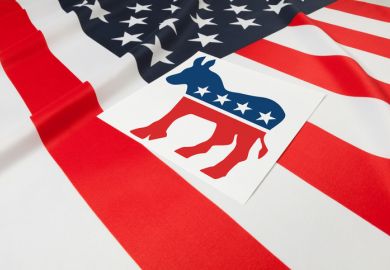Even without Bernie Sanders, US college students may be ready to break their habitual failure to convert enthusiasm into actual votes, thanks to a key new ally: their institutions.
Ahead of November's presidential election, students and their outside allies are increasingly turning to universities themselves for help to encourage registration and turnout. And, for the most part, institutions have jumped in, integrating more and more voter-assistance processes into their own operations.
The result is a proliferation of official assistance and voting-related structures, such as registration options offered during course enrolment and election-day reminders added to campus communications.
It amounts to official recognition, said Jen Domagal-Goldman, executive director of the ALL IN Campus Democracy Challenge, of the importance of the student vote and the limits posed by their annual turnover.
“If you leave it to students,” Dr Domagal-Goldman said, “you’re creating the same cycles over and over again, and you’re asking them to kind of recreate a wheel, instead of building it into campus culture and systems.”
“We’re essentially working institutionally, getting the schools to do as much as they can,” said another proponent, Paul Loeb, founder and president of the Campus Election Engagement Project. “It’s very much working from within.”
Implementation has been building slowly over decades, before accelerating in the era of sophisticated online tools. The tactics have improved yet again in more recent years, with the growth of precision data on students, their home districts and their voting behaviours.
A breakthrough came in the 2018 congressional elections, when 40 per cent of US college students cast ballots, more than double the previous mid-term turnout of 19 per cent. It marked “a staggering increase”, Mr Loeb said.
Much of that increase was attributed to anxiety over the Trump presidency, which drove mid-term turnout among all voters to its highest rate in a century.
But public attention on the anti-Trump fervour of 2018 may have helped hide the credit due to the university-based efforts, both Mr Loeb and Dr Domagal-Goldman said.
With those two factors combined this year, Dr Domagal-Goldman said, the presidential-year turnout of 51 per cent of college student voters in 2016 − similar to their 48 per cent rate in 2012 − could soar this November to 60-65 per cent.
Yet 2020 also brings the unusual circumstances of the coronavirus, with important questions that include whether colleges resume in-person classes in the fall, and whether states allow mail-in ballots.
Advocates of student voting, however, are experienced in governmental efforts to hold down their numbers, Mr Loeb said. After Wisconsin leaders enacted a series of hurdles to voting, Mr Loeb’s group enlisted Joe Gow, the chancellor of the University of Wisconsin-La Crosse, to create a video in which he comically portrays a confused new student voter getting registration advice as he walks around campus.
Advocacy groups are also putting a priority on creating information packets that provide summaries of candidate positions, with what they promise is heavy attention to the long-term imperative of unbiased presentations.
Mr Loeb recalls a post-election visit to one university class in which he learned that a full 95 per cent of them voted. The professor then explained that he had found voter guides produced by Mr Loeb’s group. “We printed 4,000 copies and put them in everybody’s mailbox,” the professor told him.
In both online and text communications to students, Dr Domagal-Goldman said, success means figuring out the right amounts, timing and frequency of delivery. A critical element, she said, given the number of students seeking a reason to vote, is candidate information personalised to each student’s voting precinct.
Even with all that help, some US college students may remain determined not to vote. At Harvard University, the local College Students for Bernie group said it was too disappointed with their candidate’s loss to endorse the likely Democratic nominee, Joe Biden.
The absence of Senator Sanders on the November ballot “will have disastrous consequences for youth turnout”, said one undergraduate with the group, James Coleman. “Some will be begrudgingly casting their vote for Biden,” he said. “Some will not.”
Register to continue
Why register?
- Registration is free and only takes a moment
- Once registered, you can read 3 articles a month
- Sign up for our newsletter
Subscribe
Or subscribe for unlimited access to:
- Unlimited access to news, views, insights & reviews
- Digital editions
- Digital access to THE’s university and college rankings analysis
Already registered or a current subscriber?







